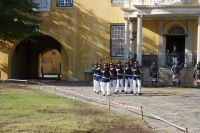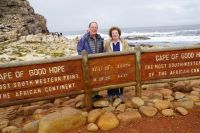Cape Town, May 8, 2019
The Chinese word for scenery combines the characters for mountain and water. In that sense, the Western Cape certainly has the two, which help explain both the allure and the history of the Cape Colony.
The Cape of Good Hope was first rounded by the Portuguese explorer, Bartholomew Diaz in 1488. Being a sailor, he named it the “Cape of Storms.” King Joao of Portugal (or his astute marketers) rechristened it the Cape of Good Hope, based on his good hope that it would help Portugal secure the spice trade recently closed off by the Ottoman conquest of Constantinople, effectively closing the Mediterranean route to the Spice Islands.
Joao was right; it did open up the way for Portugal’s global sea empire, but not necessarily the opening of Cape Town. That took the Dutch supplanting the Portuguese (and nearly 200 years) until the Dutch East India Company  established a fort, now the Castle of Cape Town. We visited this wonderful outpost of the VOC (the company in Dutch) and learned a bit more about the colony under the Dutch. Come and settle, help us re-provision ships bound for the Indies, and increasingly, fight off the locals (the Khoi-an and the Dutch fought some 17th century wars; the Khoi-an were outgunned, but recognized the matchlocks did not fire when wet, so attacked during rain storms, and thus stalled the inevitable). In the meantime, the Dutch built a hedge around the colony to keep the Khoi-an at bay, and the company also invited French Protestants (who had fled to the
established a fort, now the Castle of Cape Town. We visited this wonderful outpost of the VOC (the company in Dutch) and learned a bit more about the colony under the Dutch. Come and settle, help us re-provision ships bound for the Indies, and increasingly, fight off the locals (the Khoi-an and the Dutch fought some 17th century wars; the Khoi-an were outgunned, but recognized the matchlocks did not fire when wet, so attacked during rain storms, and thus stalled the inevitable). In the meantime, the Dutch built a hedge around the colony to keep the Khoi-an at bay, and the company also invited French Protestants (who had fled to the Netherlands when Louis XIV revoked the Edict of Nantes, which had tolerated Protestants) to add muscle and viniculture to the colony; the French were allotted another encampment, still today called French town in the Afrikaner language.
Netherlands when Louis XIV revoked the Edict of Nantes, which had tolerated Protestants) to add muscle and viniculture to the colony; the French were allotted another encampment, still today called French town in the Afrikaner language.
That lasted until the Napoleonic Wars, when, to keep Cape Town out of the hands of the Napoleonic French, the British seized Cape Town twice (giving it back during a temporary truce in the Napoleonic Wars), then landing 7,000 troops, armed with a letter from the Prince of the Netherlands, then an émigré in England, to hand over the property; the command at the Castle, despite working under the Batavia Republic (Napoleon’s stopgap until he could name his brother King), and facing the overwhelming force, surrendered what was to become South Africa.
The local Dutch, known better as the Boers, then began nearly a century of efforts to either accommodate or expel the British. After Britain abolished slavery in the 1830s, the Boers trekked across the mountains to another area, and set up at least two Boer-led states (the Orange Free State and the Transvaal), lasting until the Union of South Africa was created in 1911. The existence of three capitals attests to the lingering results of those wars. Parliament meets in Cape Town, the Executive capital is in Praetoria (recently renamed); Praetoria was the commander of a contingent that defeated the Zulus in the Battle of aptly named Bloody River, when 5000 Zulus were slain; and the Supreme Court is housed in Bloemfontein.
I said mountains is part of the scenery, both literal and historical, too. One handle is provided by Cecil John Rhodes, who at the time of his death in 1902 was the richest man in the world. Like the robber barons in the contemporary United States, Rhodes was both ruthless (and in this country a racist), and a philanthropist. He came to South Africa from London to seek a cure for TB, and wound up taking advantage of the discovery of gold and diamonds (he forced his competitor to sell, creating the DeBeers company, a relative monopoly on diamonds). The philanthropic part included the National Botanic gardens (we were there; that’s where I saw part of the hedge the Dutch governor had planted in one of the early efforts to separate the races), Rhodes Scholars, and the grounds and buildings of the University of Cape Town, one of the three premier institutions of higher learning in this country of almost 70 million. I think when I was here four years ago, there were student protests to remove Rhodes’ statue from the most prominent part of the UCT campus, and my understanding is that it is now in the National Gallery in London.
 As for Cape Town, the setting really is scenic. The harbor has been one of the major transshipment points for the country, though during the apartheid period (1960s through the 1990s) South Africa was an international pariah, and the port languished. A company recreated the area as a major tourist shopping and eating mecca (we’re a block away), but we’re visiting the Port Authority so I should have a better handle on what happened to it. Table Mountain, a 3500 foot high block of granite is one of the three most visited sites in the country, accessible on foot or by a $50 funicular trip; it was ranked as one of the seven wonders of the natural world, alongside Ha Long Bay, which is high praise indeed.
As for Cape Town, the setting really is scenic. The harbor has been one of the major transshipment points for the country, though during the apartheid period (1960s through the 1990s) South Africa was an international pariah, and the port languished. A company recreated the area as a major tourist shopping and eating mecca (we’re a block away), but we’re visiting the Port Authority so I should have a better handle on what happened to it. Table Mountain, a 3500 foot high block of granite is one of the three most visited sites in the country, accessible on foot or by a $50 funicular trip; it was ranked as one of the seven wonders of the natural world, alongside Ha Long Bay, which is high praise indeed.

 And there is something spectacular about the end of the peninsula, about 45 miles away, where sits the Cape of Good Hope, the furthest Southwest point on the African continent. I still marvel looking south and seeing nothing until Antarctica (I swear I saw it last time I was here), and we’re only at the 35th parallel, roughly even with Buenos Aires. I wonder what Diaz would have said had he had to sail another 30 or so degrees further to round the Cape. Storms might have been one of his gentler epithets.
And there is something spectacular about the end of the peninsula, about 45 miles away, where sits the Cape of Good Hope, the furthest Southwest point on the African continent. I still marvel looking south and seeing nothing until Antarctica (I swear I saw it last time I was here), and we’re only at the 35th parallel, roughly even with Buenos Aires. I wonder what Diaz would have said had he had to sail another 30 or so degrees further to round the Cape. Storms might have been one of his gentler epithets.
The election today dictated the day of our non-business visit to the Cape, which included one of my favorite stops—the penguin colony near Simon’s  Town. From a couple (they’re monogamous) in 1982, along with some serious environmental efforts including reduced fishing in False Bay, the colony has around 2,200 cute-as-a buttons in tuxedo-like attire diving and swimming (7 km per hour) to the amusement of nearly half a million visitors a year. There are only four species of penguins and they all live in the southern hemisphere. The colony here has been renamed African Penguin; they used to be called Jackass Penguins (and if you hear them, you’ll know why), but that probably is no longer politically correct.
Town. From a couple (they’re monogamous) in 1982, along with some serious environmental efforts including reduced fishing in False Bay, the colony has around 2,200 cute-as-a buttons in tuxedo-like attire diving and swimming (7 km per hour) to the amusement of nearly half a million visitors a year. There are only four species of penguins and they all live in the southern hemisphere. The colony here has been renamed African Penguin; they used to be called Jackass Penguins (and if you hear them, you’ll know why), but that probably is no longer politically correct.
Speaking of which, I’ll have some reflections on what has been billed as “the most important election in the history of South Africa.”